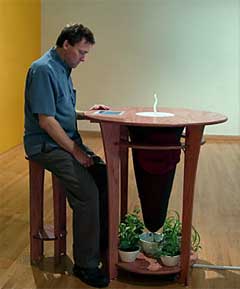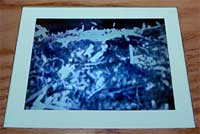 To keep your table clean of any leftover, one can either adopt the radical Katazukue way or turn to worms, sowbugs and bacteria for a more sustainable solution.
To keep your table clean of any leftover, one can either adopt the radical Katazukue way or turn to worms, sowbugs and bacteria for a more sustainable solution.
A wriggling and living ecosystem is invited to Amy Young‘s Digestive Table. After users have discarded food leftovers and shredded paper into the portal at the top, the bacteria and sowbugs begin breaking down the waste and the worms join in to further digest it into a compost that sprinkles out of the bottom of the bag that hangs beneath the table. This compost is used as a fertilizer for plants, such as those at the base of the table.
Seeing worms is difficult since the creatures are harmed by white light. They do not mind infra-red, but humans cannot see in that frequency. Therefore, Young has made a cross-section of the activity inside the compost visible using an IR security camera connected to an LCD screen built into the table. On the screen (image below), viewers can see the live movements of the worms and sowbugs inside.
The hand-made composting bag is based on a “flow-through” vermicomposting system, designed to make harvesting the worm castings much easier. Informative how-to handout, written by Amy Stewart can be downloaded here.
 The wood is Forest Stewardship Council Certified oak plywood. They have a policy to “agressively phase out the purchase of wood products from endangered forests”. In an effort to be ecological and to reference the cycle of food reprocessing, the wood was stained with a homemade concoction of boiled red cabbage, mixed with a little worm compost tea and alum.
The wood is Forest Stewardship Council Certified oak plywood. They have a policy to “agressively phase out the purchase of wood products from endangered forests”. In an effort to be ecological and to reference the cycle of food reprocessing, the wood was stained with a homemade concoction of boiled red cabbage, mixed with a little worm compost tea and alum.
Other works by Amy Young: Holodeck for House Crickets and Hairy Cactus.
